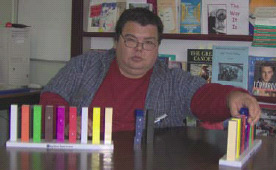
Making a collection of a million things is a very interesting procedure. Sometimes you see reports of classes collecting 1 000 000 tags from packages of bread. Collecting a million pennies would raise $10 000 for your program. In any case, making a collection of a million things usually involves publicity, since the wider community is needed to help make the collection, which means that students can talk about the process of showing what a million is; they are involved in making a system for storing, sorting, and displaying the pieces they are collecting; it takes time, so the immensity of the number has time to set in, and it provides a repetition of noticing smaller amounts-10 tens make 100 and 10 hundreds make 1000 many, many times during the process of collecting a million of anything.
There is lots of room for ratio and proportion in this project: if 100 items weigh five grams, how much will 1 000 weigh? 10 000? 100 000? If it takes three minutes to count 100 pennies and put them in the plastic case, how long will it take to deal with 1 000 pennies? How long will it take to wrap the million pennies?
Student activities using fraction manipulatives start on page 72.


Some examples are shown above. See page 26 for sources of commercial manipulatives.